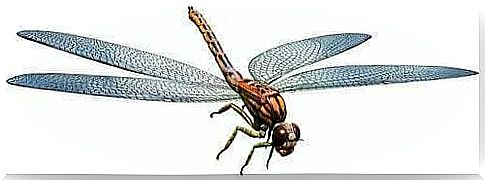The Kingdom Of Giant Insects: The Carboniferous Period

Millions of years ago, the sky was populated by flying insects, very similar to dragonflies, of gigantic size. This is because, of course, the atmospheric conditions and the animals that inhabited the Earth were very different from those we know today. In this article, we will talk about the fascinating kingdom of giant insects.
Scientists have posed various hypotheses to explain why giant insects have disappeared and why these arthropods are now so small. However, it seems that the answer lies in the evolution of the predatory birds of that time, which acquired more effective ways of capturing their prey.
How about learning more about how these insects got so big and why these species disappeared? Read on.
The protodonates: giant dragonflies
The size of the animals is the result of the relationship that is established between their body and the physiological and ecological characteristics of the environment in which they are found.
During the Carboniferous period (at the end of the Paleozoic era), there were insects of very different size from what we know today. An example is that of the Protodonata , an order of now extinct insects.
Aesthetically they were similar to dragonflies, but some of them were as big as an eagle. Thanks to the fragments of wings that have been recovered, we know that some were up to 70 centimeters in diameter.
Protodonates are the largest group of insects ever to exist on Earth. Among all, Meganeura , Megatypus and Meganeuropsis are the best known genera.

The appearance and disappearance of giant insects
After the discovery of the fossil remains of these arthropods in 2012, scientists at the University of Santa Cruz, California, speculated on the influence of several factors, always in an attempt to explain how these beings could have reached this size and why they became extinct.
Oxygen, responsible for the development of giant insects?
During the Carboniferous, the amount of atmospheric oxygen was higher than it is now. The oxygen an organism needs depends on the size of its body: the larger the animal, the more oxygen it needs.
Unlike other ectothermic animals, which regulate body heat based on the environment, respiration in insects occurs through a tracheal system. That is, oxygen diffuses through branched tubes that irrigate the entire body.
The flying insects of that time had to adapt to the different concentrations of oxygen, as a lot of energy is required for the movement of the wings. Because of this, one of the first physiological changes they had to experience was that of the respiratory system.
The predators of giant insects
There is another possible explanation that helps us understand why these insects were giants. In this case, let’s talk about the competition for food with other flying insects and vertebrates, such as:
- birds,
- bats,
- pterosaurs.
Fossil evidence indicates that predation may have retained control over the evolutionary dimension of some animals.
Predation vs oxygen
In the next era, that of the Mesozoic, during the early Cretaceous, insects began to get smaller and smaller, despite the fact that the concentration of atmospheric oxygen increased.
This fact supports the hypothesis that predation by other insects and flying animals is the reason the insects have shrunk. This coincides with the time when birds have improved their ability to capture prey and their physiological structures.
In short, oxygen influenced the size of giant insects from the Carboniferous to the Triassic. However, as scientists Clapham and Karr point out in their research work, it appears that insect interactions with predatory birds and their abilities were the deciding factor.
Therefore, the evolution of these birds would have been responsible for the size of the insects, replacing the explanation of oxygen as the main factor.

A breach in time
Despite the fascinating findings from the fossil record, scientists doubt that predation was the cause of the demise of the giant insect kingdom.
This uncertainty is due to the fact that there is not enough information drawn from the fossil record of over 20 million years. Therefore it is not possible to know exactly when this event occurred.
Finally, although there is a time lag that makes it difficult for us to find the answer we have suggested, we might think that these scientists are not very far from the solution.
After all, the theory that the time birds became more agile coincided with the reduction in size of these insects makes perfect sense.









